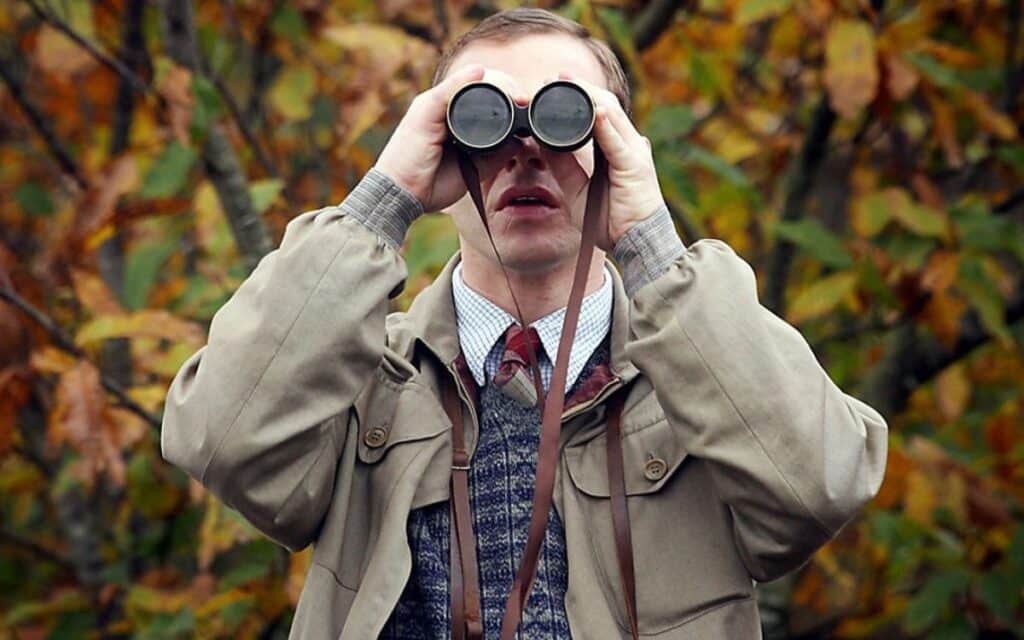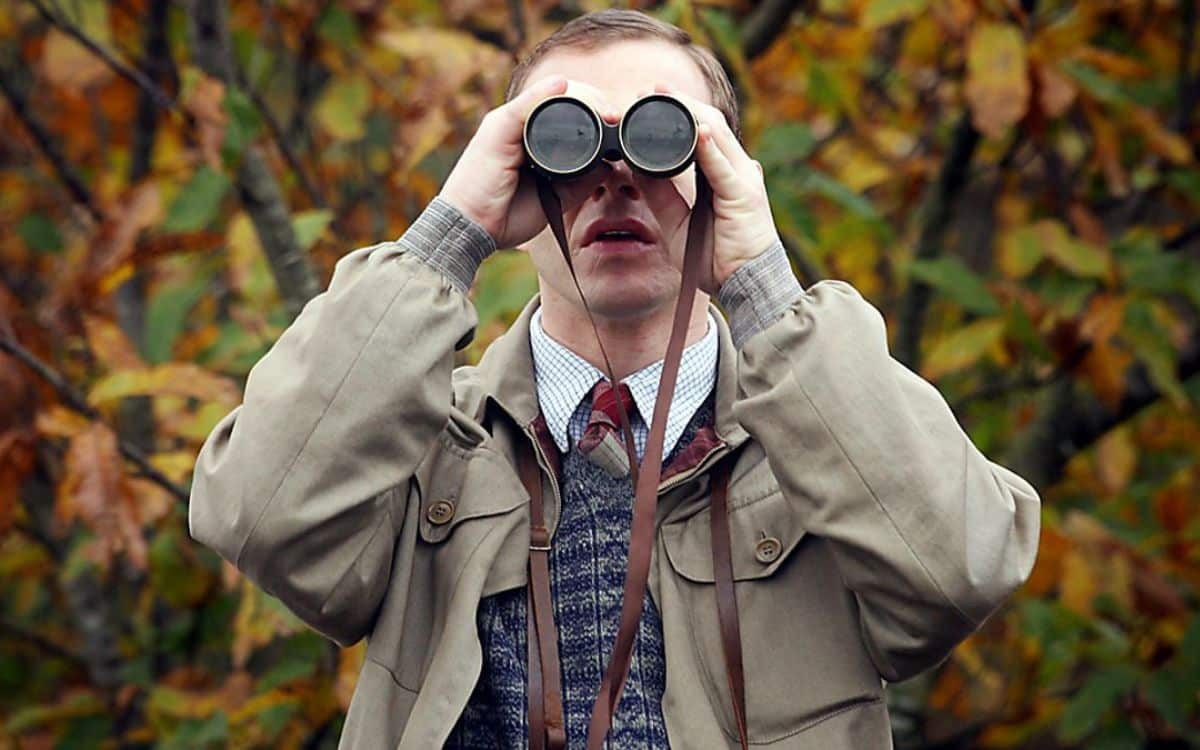A View from a Hill 2005 is an eerie, tense and faithful A Ghost Story for Christmas that slightly misses the original series’ brilliance but remains essential for genre fans, writes RICHARD MARKWORTH

TITLE: A View From A Hill
RELEASE DATE: 23 December 2005 on BBC Four
DIRECTOR: Luke Watson
CAST: Mark Letheren, Pip Torrens, David Burke, Simon Linnel
Review of A View From A Hill 2005
Having lain slumbering in its tomb since 1978’s The Ice House, the BBC’s A Ghost Story For Christmas strand was eventually exhumed and resuscitated in 2005. For this welcome revival, writer Peter Harness looked to the heyday of the classic series and, as was the familiar practice of director Lawrence Gordon Clark in the 1970s, chose to adapt a story from the masterful works of M R James.
A View from a Hill presents us with a typical Jamesian protagonist, Dr Fanshawe (Mark Letheren), an academic whose overwhelming curiosity is destined to bring him into contact with sinister forces. Arriving at a rural train station, Fanshawe, replete with luggage and bicycle, awaits the expected provision of transport by Squire Richards (Pip Torrens) who has employed the young archaeologist to catalogue and assess the value of his collection of historical artefacts.
However, once it becomes obvious his wait is in vain, Fanshawe opts to cycle to the Squire’s stately residence. Whilst traversing a lonely woodland road, Fanshawe’s suitcase falls from his bicycle, forcing him to halt and retrieve it. He resumes his journey, ultimately arriving at the Squire’s isolated manor house without further incident.
Fanshawe tries the bell but receives no answer. It appears the property is deserted until the Squire exits the building, clearly about to set off on a constitutional. The Squire is surprised to see Fanshawe due to confusion over his arrival date but, nonetheless, invites the young doctor to join him on his walk once his surly servant, Patten (David Burke), has shown him to his room and allowed him to get settled.
Fanshawe finds the guest room to be layered with dust, indicating the mansion has seen better days. As he meticulously unpacks his possessions, Fanshawe discovers his binoculars were damaged when his case fell from his bicycle, rendering them unusable. Squire Richards locates an old pair for him to borrow and the two men embark on their walk.
As the men stroll through the surrounding countryside, the Squire points out various places of interest to Fanshawe. These include Gallows Hill, where miscreants were executed in days gone by, and the devastated remnants of ancient Fulmaker Abbey, dissolved by Henry VIII. However, when Fanshawe views the site of the abbey through the ancient binoculars, it appears to be fully intact. When a confused Fanshawe raises this with Richards, the Squire is dismissive, assuming the young man had focused on a nearby church in error.
Returning to the Squire’s home, the men are confronted by an agitated Patten who believes they have been victims of a robbery as the binoculars are missing. The Squire testily corrects him.
Over dinner that night we learn Squire Richards wishes Fanshawe to authenticate his array of artefacts as he needs to sell off “the family silver” to fund the upkeep of his decaying home. Financial circumstances are so dire, Richards does not even pay Patten, his only servant, which helps to explain the butler’s less than convivial attitude.
The men discuss the Squire’s inherited collection, including items purchased by his father from the estate of a local watchmaker and amateur archaeologist named Baxter (Simon Linnell) following his mysterious death. Intriguingly, Richards informs Fanshawe some of Baxter’s assorted pieces are “pretty bizarre”, and the man himself “wasn’t liked.”
Fanshawe finds himself inexorably drawn to Baxter’s papers and historical objects which include a grotesque skull faceplate and a contemporary, but detailed, sketch of the abbey in its former glory pencilled by Baxter himself.
Fanshawe sets out alone to visit the ruins at close quarters, venturing into the secluded environs of the countryside, which lay silent but for the ambient sounds of nature. As Fanshawe examines the sparse remains of the abbey, a shadowy figure observes him.
Riding on, Fanshawe happens across the unsettling figure of a local poacher. After nodding his acknowledgment to the watching stranger, Fanshawe continues his journey to Gallows Hill. As he moves deeper into the woods, now forced to push his bicycle, Fanshawe grows increasingly unnerved. As the daylight begins to fade, and Fanshawe crouches to repair a puncture, it is chillingly apparent something is stalking him in the darkness. He spins around as if touched by an unseen hand while the sounds of movement abound in the surrounding foliage.
Fanshawe’s headlamp fails to reveal his pursuer and finally, his nerve broken, he flees panic-stricken from Gallows Hill. Mercifully, he returns unharmed to the stately home where the anxious-looking Squire and Patten are there to meet him.
Over dinner a ruffled Fanshawe explains he felt Gallows Hill to be “an unnatural kind of place”. A lurking Patten, to the Squire’s chagrin, asks Fanshawe if he had taken the binoculars with him. The Squire instructs Patten to sit down if he has something to tell them.
Patten reveals his father had served on Baxter’s inquest where a “verdict of unsound mind” was reached. He states Baxter had excavated the bones of hanged criminals from Gallows Hill and “started to get some funny ideas of how to spend his nights!”
Patten informs them one of Baxter’s final projects was the creation of the binoculars Fanshawe had borrowed. In flashback, we see Baxter constructing the binocular’s lenses utilising liquid matter, implied to have been acquired by boiling the bones of the executed, in their formation. We then witness Baxter observing the abbey through the magical glasses, allowing him to view the building in its original condition and using this supernatural reference point to accurately sketch the building. It is clear Patten believes the angered spirits of the dead were responsible for Baxter’s demise.
Despite these thunderously loud alarm bells and unsurprisingly suffering from vivid nightmares, Fanshawe finds himself unable to resist returning to the site of the abbey the next day.
Following in Baxter’s footsteps, he takes the binoculars and, through their necromantically enchanted lenses, once again views the undamaged version of the abbey. He cycles to the spot eager to investigate the ruins at closer proximity with the aid of the glasses. However, this foolhardy obsession will soon lead him to face the consequences of prying into matters beyond the natural realm.
Whilst not quite hitting the heights of the original 1970s run, A View from a Hill is nonetheless an excellent return for the series and, with its themes of the dangers of pursuing forbidden knowledge and the price of antagonising ancient powers, sits comfortably alongside its predecessors.
Director Luke Watson expertly crafts scenes of mounting tension, in particular the sequence where Fanshawe is menaced by unseen entities before fleeing Gallows Hill. He effectively presents the countryside as a strange, otherworldly environment where the wooded landscape, and the dark secrets it harbours, await the arrival of unwary visitors in spider-like fashion.
The small cast are well chosen with Letheren ably suited to the role of the curious but naïve Fanshawe and Torrens standing out as the dry-witted, sardonic Squire.
Unfortunately, this spooky treat would not herald an immediate full re-instatement of the strand, and the sustained regularity of further episodes was not truly established until Mark Gatiss inherited creative responsibility for the series.
However, it proved A Ghost Story for Christmas still deserved a place in the Yuletide viewing schedules and undoubtedly helped pave the way for the current ongoing series. For this, genre fans should surely raise a cracked glass in gratitude.
Tell us your thoughts on A View From A Hill 2005 in the comment section below!



